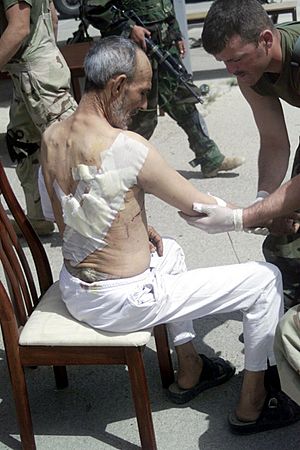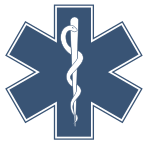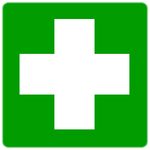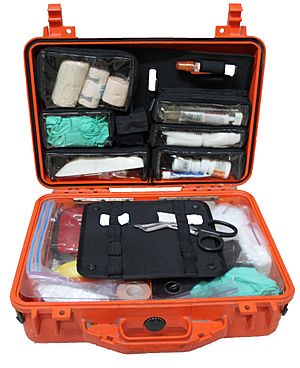First aid facts for kids
First aid is about knowing how to help someone who suddenly gets sick or hurt. It's used at accidents to help an injured person until doctors, nurses, or an ambulance arrive. First aid also helps people who suddenly feel unwell, until they can get to a hospital or clinic.
You don't need a lot of special equipment to give first aid. A collection of useful first aid items is called a first aid kit. But you can still save lives even without a kit! First aid can be done almost anywhere an emergency happens. In places far from hospitals, first aid might be the only help available until the person can reach a hospital or clinic.
People who answer emergency calls (called Emergency medical dispatchers) are trained in first aid. If you call for help, they can tell you what to do until the ambulance gets there. This might include tips like the "C-A-B" steps mentioned below.
Contents
Why is First Aid Important?

First aid skills are kept simple on purpose. This makes them easy to remember and use in an emergency to help save a life.
One way to remember the main goals of first aid is with the "Three P's":
- Preserve life – This means trying to stop the person from dying.
- Prevent further injury – This means stopping the person from getting hurt even more. If possible, an injured person should not be moved. First aid also teaches how to move injured people safely, or with less harm if you have no other choice.
- Promote recovery – This means trying to help the person heal from their injuries.
Another important set of goals for keeping a badly hurt person alive is sometimes called "C-A-B":
- Circulation (or Compressions) - This is about keeping blood inside the body and the heart beating. Compressions are part of CPR. This is where someone pushes on the center of a person's chest over and over. This helps keep blood flowing to the brain. You don't need a kit for this, and it only takes a little training. Emergency call dispatchers can even guide you through it over the phone.
- To keep blood inside the body, you can use a piece of cloth to press firmly on the bleeding area. This "direct pressure" is the easiest and best way to stop bleeding. Other methods, like a tourniquet, are taught in first aid classes. If you don't have a first aid kit, you can make a cloth "dressing" from ripped clothing.
- Airway - This means keeping a clear path for air to go from the mouth to the lungs. If someone has vomited ("thrown up"), turning them on their side can help keep their airway open so they can breathe. Moving a hurt person can make their injuries worse. But without an airway, a person can't breathe and will quickly die. A person who is choking can be helped with abdominal thrusts, also known as the Heimlich maneuver.
- Breathing - This means moving air from outside into the lungs. "Giving breaths" means blowing air into someone else's mouth while holding their nose shut. You watch their chest rise as you blow air in. This is taught as part of CPR. A helper could get sick if the person has a disease. A CPR class can teach you how to use a CPR mask to make this much safer. A first aid kit might include a CPR mask or a barrier device.
Learning First Aid
You can learn about first aid from books and videos. A good first aid kit often comes with a simple guide.
It's best to get proper training to give first aid. Besides books and videos, good training includes a teacher and a chance to practice. For example, CPR is practiced on a special dummy called a manikin. This lets you learn how to push on someone's chest without actually doing it to a real person. The teacher makes sure you are doing the skills correctly.
Training can be given by groups or by medical professionals like doctors, nurses, or paramedics. Organizations that teach first aid include the International Red Cross, schools, hospitals, the military, Scout groups, and rescue teams like fire departments.
The amount of training needed to be a first aid helper changes from country to country. For example, in the United Kingdom and the United States, you can take a 1-day course to become a first aid giver. In the U.K., you can take a 4-day course for emergencies at work. All firefighters, police officers, and soldiers learn first aid during their basic training.
What's in a First Aid Kit?
First aid kits can be found in cloth bags or plastic or metal boxes. They often have a special symbol, like the ones at the top right of this page. A first aid kit can hold many things, but here are some basic items that are very helpful:
- Gloves for the helper's hands, made of vinyl, latex, or nitrile. These protect the helper's hands from blood.
- Dressings made of cloth that can be placed on wounds to stop bleeding. These are like gauze pads or sanitary napkins.
- Bandages of gauze or cloth that hold dressings tightly over wounds. Sometimes these come in rolls.
- Rolls of tape to hold dressings and bandages in place.
- Scissors that can cut tape, open clothing, and make more bandages or dressings.
- CPR masks or barriers to make it safe and clean for a helper to breathe into someone's mouth during CPR.
- Blanket made of cloth or Mylar ("space blanket") to cover a sick or hurt person and keep them warm.
- A small first aid book which shows how to do first aid and reminds trained people what to do.
- Adhesive strips (small pieces of tape with a bit of cloth in the center), special dressings like moleskin for blisters, and antiseptic creams for small wounds.
- Tweezers to remove stingers, splinters, and thorns.
Images for kids
-
First aider of the British Red Cross accompanies parade of morris dancers at the Knutsford Royal May Day, Knutsford, Cheshire, England, 2012
See also
 In Spanish: Primeros auxilios para niños
In Spanish: Primeros auxilios para niños








